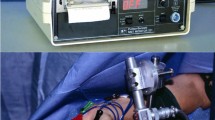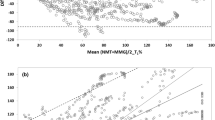Abstract
Neuromuscular blockade is usually monitored using train-of-four (TOF) stimulation pattern. A TOF ratio of higher than 90 % is recommended to reduce the risk of adverse effects after anaesthesia. TOF ratio 90 % is used in clinical practice with all different neuromuscular monitors. Kinemyography (KMG) is one commercialized method to obtain numerical TOF values. We compared the KMG data obtained with Datex M-NMT MechanoSensor™ module, to the EMG data collected with Datex ElectroSensor™, during clinical anaesthesia. Ipsilateral comparisons of the sensors were performed in 20 female patients during clinical procedures in propofol–remifentanil anaesthesia. After initial bolus dose of rocuronium (0.6 mg/kg), the spontaneous recovery of TOF ratio and T1 % were monitored. KMG gave higher TOF values than EMG. The difference was significant at KMG TOF values of 40 % or higher. After anaesthetic induction, but before administration of rocuronium, both TOF sensor values drifted from the TOF value of 1.0, showing either significant spontaneous fade (T1 > T4) or tendency of reverse fade (T1 < T4). KMG overestimates the recovery from neuromuscular blockade when compared with EMG. KMG and EMG cannot be used interchangeably, and TOF ratio 90 % cannot be considered as adequate level of recovery with all monitoring devices.




Similar content being viewed by others
References
Fuchs-Buder T, Claudius C, Skovgaard LT, Eriksson LI, Mirakhur RK, Viby-Mogensen J. Good clinical research practice in pharmacodynamic studies of neuromuscular blocking agents II: the Stockholm revision. Acta Anaesthesiol Scand. 2007;51:789–808.
Eriksson LI, Sundman E, Olsson R, Nilsson L, Witt H, Ekberg O, Kuylenstierna R. Functional assessment of the pharynx at rest and during swallowing in partially paralyzed humans: simultaneous videomanometry and mechanomyography of awake human volunteers. Anesthesiology. 1997;87:1035–43.
Miller. Neuromuscular monitoring. In: Miller’s anesthesia. 7th ed. Chapter 47.
Eriksson LI, Lennmarken C, Wyon N, Johnson A. Attenuated ventilatory response to hypoxaemia at vecuronium-induced partial neuromuscular block. Acta Anaesthesiol Scand. 1992;36:710–5.
Eriksson LI, Sato M, Severinghaus JW. Effect of a vecuroniuminduced partial neuromuscular block on hypoxic ventilator response. Anesthesiology. 1993;78:693–9.
Eriksson LI. Reduced hypoxic chemosensitivity in partially paralysed man. A new property of muscle relaxants? Acta Anaesthesiol Scand. 1996;40:520–3.
Sundman E, Witt H, Olsson R, Ekberg O, Kuylenstierna R, Eriksson LI. The incidence and mechanisms of pharyngeal and upper esophageal dysfunction in partially paralyzed humans. Pharyngeal videoradiography and simultaneous manometry after atracurium. Anesthesiology. 2000;92:977–84.
Carter JA, Arnold R, Yate PM, Flynn PJ. Assessment of the Datex Relaxograph during anaesthesia and atracurium-induced neuromuscular blockade. Br J Anaesth. 1986;58:1447–52.
Motamed C, Kirov K, Combes X, Duvaldestin P. Comparison between the Datex-Ohmeda M-NMT module and a forcedisplacement transducer for monitoring neuromuscular blockade. Eur J Anaesth. 2003;20:467–9.
Dahaba AA, von Klobucar F, Rehak PH, List WF. The neuromuscular transmission module versus the relaxometer mechanomyograph for neuromuscular block monitoring. Anesth Analg. 2002;94:591–6.
Stewart PA, Freelander N, Liang S, Heller G, Phillips S. Comparison of electromyography and kinemyography during recovery from non-depolarising neuromuscular blockade. Anaesth Intensive Care. 2014;42(3):378–84.
Gaffar EA, Fattah SA, Atef HM, Omera MA, Abdel-Aziz MA. Kinemyography (KMG) versus Electromyography (EMG) neuromuscular monitoring in pediatric patients receiving cisatracurium during general anesthesia. Egypt J Anaesth. 2013;29:247–53.
NMT Appliguide. GE-Healthcare OY, Helsinki, Finland.
Schnider TW, Minto CF, Gambus PL, Andresen C. The influence of method of administration and covariates on the pharmacokinetics of propofol in adult volunteers. Anesthesiology. 1998;88:1170–82.
Minto CF, Schnider TW, Shafer SL. Pharmacokinetics and pharmacodynamics of remifentanil II. Model application. Anesthesiology. 1997;86:24–33.
Bland JM, Altman DG. Statistical methods for assessing agreement between two methods of clinical measurement. Lancet. 1986;1:307–10.
Claudius C, Skovgaard LT, Viby-Mogensen J. Arm-to-arm variation when evaluating neuromuscular block: an analysis of the precision and the bias and agreement between arms when using mechanomyography or acceleromyography. Br J Anaesth. 2010;105(3):310–7.
Cammu G, De Witte J, De Veylder J, Byttebier G, Vandeput D, Foubert L, Vandenbroucke G, Deloof T. Postoperative residual paralysis in outpatients versus inpatients. Anesth Analg. 2006;102:426–9.
Ueda N, Muteki T, Tsuda H, Inoue S, Nishina H. Is the diagnosis of significant residual neuromuscular blockade improved by using double-burst nerve stimulation? Eur J Anaesthiol. 1991;8:213–8.
Viby-Mogensen J, Jensen NH, Engbæk J, et al. Tactile and visual evaluation of the response to train-of-four nerve stimulation. Anesthesiology. 1985;63:440.
Acknowledgments
Authors do not have a financial relationship with the organization that sponsored the research.
Conflict of interest
The authors declare that they have no conflict of interest.
Author information
Authors and Affiliations
Corresponding author
Rights and permissions
About this article
Cite this article
Salminen, J., van Gils, M., Paloheimo, M. et al. Comparison of train-of-four ratios measured with Datex-Ohmeda’s M-NMT MechanoSensor™ and M-NMT ElectroSensor™. J Clin Monit Comput 30, 295–300 (2016). https://doi.org/10.1007/s10877-015-9717-4
Received:
Accepted:
Published:
Issue Date:
DOI: https://doi.org/10.1007/s10877-015-9717-4




